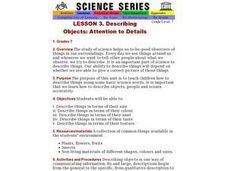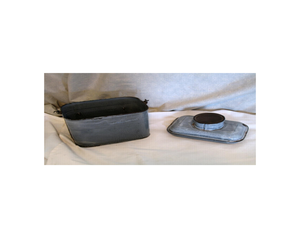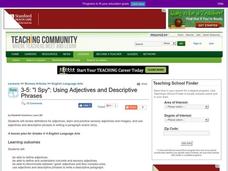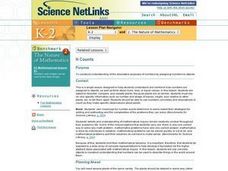Curated OER
It Counts
Young scholars assign numbers to describe objects. In this number instructional activity, students assign numbers to objects and compare more, less, and equal values. They write down descriptions of plants including the number of leaves...
Curated OER
Hand Sensitivity
Students experiment with the sense of touch. In this tactile lesson plan, students determine the most sensitive area of the hand. Students experiment by describing objects through touch only. Students compare the amount of sensory data...
Curated OER
Building Staircases: Understanding Slope
Students recognize the importance of slope. They use blocks to model the slope of a line and calculate the slope of a line on a coordinate grid. Afterward, they describe objects they encounter in their everyday lives that have slopes.
Curated OER
Galaxies – Descriptive Writing
Learners explore the five senses and how to incorporate them into their writing to make it come to life. For this descriptive writing lesson, students must describe objects by touching them without seeing, and describe different...
Curated OER
Elaborating: Specific Adjectives
Students use adjectives to improve their descriptive writing. In this language arts lesson, students discuss adjectives that can be used to describe objects. Students complete sentences by selecting adjectives.
Curated OER
Colors: What is Pink?
Students study colors. They listen to poems, identify their favorite colors, and describe objects that are pink, red, and orange. They collect pictures from magazines of objects that are their favorite color and create a class dictionary.
Curated OER
Description Words
In this descriptive words worksheet, students identify each picture. Students then write three descriptive words that describe the toys in each picture.
Curated OER
Describing Objects: Attention to Details
Seventh graders study how observation and accurate descriptions are an important in science. They use basic science words in their descriptions.
Mathematics Vision Project
Module 5: Modeling with Geometry
Solids come in many shapes and sizes. Using geometry, scholars create two-dimensional cross-sections of various three-dimensional objects. They develop the lesson further by finding the volume of solids. The module then shifts...
Hawaiʻi State Department of Education
Push and Pull
I love mixing arts lessons with core content! Here, the class will discuss energy, motion, and force (push/pull) as they review dance vocabulary and movements. They preview vocabulary for force and dance. Then they pair-up to dance a...
Curated OER
CPO Science - Foundations of Physics
An object in motion will remain in motion, and your physics learners will really get moving by viewing this PowerPoint! They examine each of Newton's laws of motion, learning about force, inertia, acceleration, and equilibrium. They are...
Teach Engineering
Determining Densities
Don't be dense—use a robust resource. The second installment of a five-part Floaters and Sinkers unit has learners determine the densities of several objects. As part of the activity, they learn the displacement method for finding...
Curated OER
Sink or Float?
Have your class explore density and buoyancy using this resource. Learners read the book Who Sank the Boat, and use several items, such as rubber balls, bottle caps, wood, and other household items to conduct an experiment. Using a tub...
Curated OER
Let's Go Exploring!
Use a Courbet painting of a cave or tunnel opening to reinforce the importance of descriptive writing. Writers of all ages use sensory details to describe what the scene depicts as they pretend to be in the painting. Then they imagine...
Curated OER
Story Mapping
Fill-out a story map to help your scholars with pre-writing. They will use a story map template to pre-write. They also organize their ideas into steps which become the foundation for their first draft. Concrete objects are brought in to...
Curated OER
Express Yourself
First graders identify details that make reading and writing more interesting. They classify events, people, places, and things and attach specific characteristics to each one. Everyone generates describing words on a worksheet that's...
ARKive
Nocturnal Animals
How do those nocturnal animals see in the dark? This perplexing question does have an answer. First, little ones use their sense of touch to determine the name of a mystery object, then they listen closely to identify various animals by...
Curated OER
As a Matter of Fact
Elementary-aged scientists discover that all matter has mass. They are shown the difference between mass and weight, and learn how to calculate mass using the appropriate tools and methods. The scientific method is used while estimating...
Curated OER
Lunch Pail
Explore a 1900s lunch pail. In this oral language and 1900s history lesson, students view a photograph of an old-fashioned lunch pail. Students describe the object and make predictions about what it is and its possible uses. Students...
Curated OER
You are the Archaeologist
Kids can practice their observation and evidence-based argument skills with a fun and engaging look at artifacts. With a given set of objects, each child will sketch and describe the object, then partners work together to determine...
Curated OER
"I Spy": Using Adjectives and Descriptive Phrases
Students define adjectives and use adjectives and descriptive phrases to write a descriptive paragraph. They write a description of a sensory item, and read and discuss a five senses chart. Students then complete a chart using adjectives...
Curated OER
It Counts
Learners classify and compare plants using specific information, observations, and numbers. In this mathematical inquiry lesson, students use plant characteristics to describe, compare, and classify them. They attempt to develop a system...
University of Arizona
Fusing Firecrackers with Narrative
Improve your youngsters' descriptive writing. They study an object and write about what they see as a warm-up, then they read an excerpt from Paul Guest's memoir, One More Theory about Happiness. The next part of the...
Curated OER
"Ing" Words as Descriptors
This clever lesson has your students listen to story about bugs, work together to brainstorm list of "ing" words that describe bugs, create t-chart of words, choose words to place in poem template to create class poem about bugs, and use...























